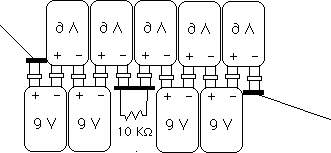
A neon glow tube
These are really dim bulbs
Introduction
Neon glow tubes are low power, high voltage lamps. A neon glow tube will glow when as little as 10-12 amps, a picoamp, flows through it. However, it takes over 80 volts to make one glow.

A neon glow tube
Material
Neon glow tube (available from Radio Shack)
High voltage power supply, you’ll need about 80 volts.
A stack of 9, of the cheapest 9 volt batteries works well.
two 9 volt battery connectors
6 clip leads
resistors, 10K , 100 K, 1 meg
capacitors, 1 to 100 microfarads at 100 volts, non-polar capacitors
are easiest to use and hardest to find.(You can use polar capacitors
if you are careful to keep the positive terminal nearest the positive
terminal of the battery.)
a variable resistor or rheostat in the range from 100 Kohms to 1
megohms
a meter capable of measuring 100 volts.
Assembly

A 9 Volt battery and its connector.
A stack of 9 volt batteries can be assembled by plugging the negative terminal from one battery into the positive terminal of the next. Connect to the ends of the stack by cutting the usual 9 volt battery connector in half and connecting one half to each terminal. For safety, I suggest that you place a 10 K ohm resistor in your stack of batteries. I put a 9 volt battery connector in the center of the stack with the resistor connected between its two terminals.

A stack of 9 volt batteries with a protection resistor in the center
To Do and Notice
Use clip leads to connect the stack of batteries to the neon glow
tube.
Notice that it glows. In particular, notice there are two electrodes
inside the glow tube and that the electrode nearest the negative
terminal is the one that glows. Reverse the neon glow tube and the
electrode connected to the negative terminal is always the one that
glows. Thus glow tubes can be used to compare two voltages, the
electrode connected to the lower voltage will be the one that glows.
Both electrodes glow if they are connected to AC.
Use a rheostat to make a variable voltage power supply.
connect a 1 meg resistor in series with the neon tube and connect
them both to the variable power supply
Measure the voltage across the neon tube as you increase the voltage from the power supply. At first the tube is dark as the voltage increases. Then at about 80 volts the tube glows and the voltage drops to 70 volts. The lamp has hysteresis, it takes a higher voltage to turn on the lamp than it does to run it. In addition, the lamp can be considered as a very large resistor, thousands of megohms when it is dark, and as a small resistor when it is glowing.
Connect a capacitor across the neon tube. Notice that the lamp oscillates on and off. Measure the voltage across the tube.

When the lamp is off, current flows into the capacitor, the
voltage across the capacitor increases until the lamp turns on. When
the lamp is on, current flows out of the capacitor and the voltage
drops until the lamp turns off.
The time constant for charging the capacitor is RC the product of the
resistance and capacitance. In this case it might be 1 megohm x 1
microfarad = 1 second. (An ohm-farad is a second)
What’s Going On?
The voltage between the electrodes in the neon glow tube accelerates electrons in the gas away from the negative electrode. When the electrons gain enough energy between collisions to ionize the gas, then the gas will glow and conduct electricity.
Etc
Neon glow tubes are often sold as nightlights. The package says 1/4 watt. Neon tubes will glow for hundreds of thousands of hours before failing. They are also sold as "Guide Lights."
A home voltage tester also has neon tube and a series resistor in it.
|
Scientific Explorations with Paul Doherty |
|
30 May 2000 |